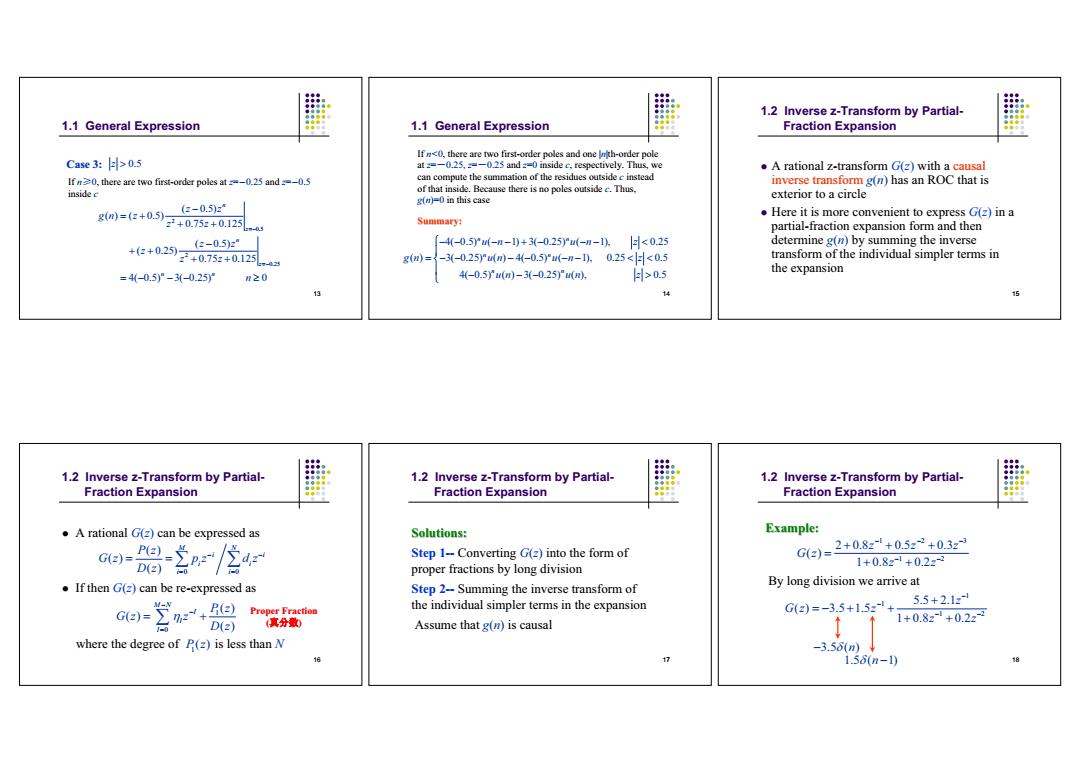正在加载图片...

1.2 Inverse z-Transform by Partial- 1.1 General Expression 1.1 General Expression Fraction Expansion Ifthere are two first-order poles and one th-order pole Case3:>0.5 at z=-0.25,2=-0.25 and z=0 inside c,respectively.Thus,we .A rational z-transform G(z)with a causal If20,there are two first-order poles at ==-0.25 and ==-0.5 can compute the summation of the residues outside c instead of that inside.Because there is no poles outside c.Thus. inverse transform g(n)has an ROC that is insidec g(n)=0 in this case exterior to a circle (2-0.5z gm=e+0.5)g+075z+0.12西 Here it is more convenient to express G(z)in a Summary: partial-fraction expansion form and then (z-05)z 「-4-0.5y(-n-1)+3(-0.25y°u(-n-1.<025 determine g(n)by summing the inverse +2+022+075z+0.12西 ()= -3(-025yum)-4(-0.5u(-n-100.25<<0.5 transform of the individual simpler terms in 4-0.5y(m)-3(-025)°(a, >0.5 the expansion =4H-0.5)°-3-025 n20 13 14 1.2 Inverse z-Transform by Partial- 1.2 Inverse z-Transform by Partial- 1.2 Inverse z-Transform by Partial- Fraction Expansion Fraction Expansion Fraction Expansion .A rational G(z)can be expressed as Solutions: Example: ) 品-/2r Step 1-Converting G(z)into the form of G2=2+0.82+0522+0.32 proper fractions by long division 1+0.8z1+0.22 If then G(z)can be re-expressed as By long division we arrive at Step 2--Summing the inverse transform of ce-艺a-号 Proper Fraction the individual simpler terms in the expansion G(z)--3.5+1.52 5.5+2.1z Assume that g(n)is causal 1+0.82+0.22 where the degree of P(z)is less than N -3.56n)↓ 1 分 1.56(n-1) 1813 1.1 General Expression Case 3: Case 3: If nı0, there are two first-order poles at z=ˉ0.25 and z=ˉ0.5 inside c z 0.5 2 0.5 2 0.25 ( 0.5) ( ) ( 0.5) 0.75 0.125 ( 0.5) ( 0.25) 0.75 0.125 4( 0.5) 3( 0.25) 0 n z n z n n z z gn z z z z z z z z n 14 1.1 General Expression If n<0, there are two first-order poles and one |n|th-order pole at z=ˉ0.25, z=ˉ0.25 and z=0 inside c, respectively. Thus, we can compute the summation of the residues outside c instead of that inside. Because there is no poles outside c. Thus, g(n)=0 in this case Summary: Summary: 4( 0.5) ( 1) 3( 0.25) ( 1), 0.25 ( ) 3( 0.25) ( ) 4( 0.5) ( 1), 0.25 0.5 4( 0.5) ( ) 3( 0.25) ( ), 0.5 n n n n n n un un z gn un u n z un un z 15 1.2 Inverse z-Transform by PartialFraction Expansion A rational z-transform G(z) with a causal inverse transform g(n) has an ROC that is exterior to a circle Here it is more convenient to express G(z) in a partial-fraction expansion form and then determine g(n) by summing the inverse transform of the individual simpler terms in the expansion 16 1.2 Inverse z-Transform by PartialFraction Expansion A rational G(z) can be expressed as If then G(z) can be re-expressed as 1 0 ( ) ( ) ( ) M N l l l P z Gz z D z where the degree of is less than N Proper Fraction Proper Fraction (ⵏ࠶ᮠ) 0 0 ( ) ( ) ( ) M N i i i i i i P z G z pz dz D z 1P( )z 17 1.2 Inverse z-Transform by PartialFraction Expansion Solutions: Solutions: Step 1-- Converting G(z) into the form of proper fractions by long division Step 2-- Summing the inverse transform of the individual simpler terms in the expansion Assume that g(n) is causal 18 1.2 Inverse z-Transform by PartialFraction Expansion Example: Example: 123 1 2 2 0.8 0.5 0.3 ( ) 1 0.8 0.2 z z z G z z z 1 1 1 2 5.5 2.1 ( ) 3.5 1.5 1 0.8 0.2 z Gz z z z By long division we arrive at 3.5 ( ) n 1.5 ( 1) n ����